


 |
 |
 |
| HomeAbout Billiards DigestContact UsArchiveAll About PoolEquipmentOur AdvertisersLinks |
|
Browse Features
Tips & InstructionAsk Jeanette Lee Blogs/Columns Stroke of Genius 30 Over 30 Untold Stories Pool on TV Event Calendar Power Index |
Current Issue
Gone Viral From his bedroom to a million subscribers and a billion views, Florian “Venom” Kohler brings an aggressive creativity to trick shots that has made him pool’s breakout online star.
Social media – and the online world as a whole – is easy to dismiss by the pool world. The game is an inherently analog endeavor, with the simplicity of six pockets, 16 balls and two people. Facebook, Twitter and online message boards are great, but they don’t seem necessary. Unless, of course, your goal is to reach as many people as possible.By Nicholas Leider Florian Kohler is a star made for this moment. The 31-year-old trick shot phenom built his following from early YouTube videos of tricks performed on his home table into a career as pool’s most recognizable artistic force. Raised in eastern France but now based in Las Vegas, Kohler’s videos have collected more than a billion views. His brash, dynamic approach to trick shots, along with his natural ease as a performer, has made him a leading entertainer and ambassador for pool. The story of how this all came about is one of a particular person made for a particular time. It is a story of how someone who grew up online leveraged the tools available to him to become a star.
Finding the Game – Eventually For much of his early life, Kohler didn’t pay much attention to pool. Outside of a few games to kill time while hanging out with friends at a bowling alley near his home in France, he wasn’t that familiar with cue-related endeavors. But when he was 18, approaching his graduation from high school, Kohler heard a radio ad from a local resident looking to sell an old six-foot table.“I begged my parents to go get it,” he said. “It was cheap – something like $300 – and I thought it’d be something fun to try. I can’t say really where it came from.” Most of us can identify with a restless teenager looking for new hobbies. Bedroom closets and basements are full of sports equipment, guitars and skateboards collecting dust. But for Kohler, this curiosity turned out to be an inflection point in his young life. Unlike many pool-origin stories, Kohler’s was a solo endeavor. He didn’t get bit with the pool bug after a father or uncle brought him to the poolhall. He didn’t have a buddy who was always up to play. Instead, the 18-year-old kid had a new table (to him, anyway) at home and no real clue how to go about learning. The natural answer? Get online and see what’s out there. “I saw videos of a few guys doing trick shots, so I figured I’d learn to do those and that will teach me to play pool,” Kohler said. “I did that for a year or two – just teaching myself all these trick shots that have been done for the last 60 or 70 years.” He posted his first video on YouTube on March 17, 2007. (Go take a look – it’s still online.) A far cry from the slickly produced videos of today, it shows a lanky kid with an impressive stroke. Kohler masses around a column of Smirnoff Ice bottles. (It was 2007, after all.) He invents a handful of shots that show what kind of creativity would make him the most seen trick shot artist in the world. But these early videos hardly lit the internet on fire. Even to this day, they only have a few thousand views. All the while, he continued to excel in school, working his way through college and graduate school, to become a licensed optometrist. But he was developing his side hustle into something much more than a way to unwind after work. “I was working during the week and then flying to tournaments on the weekend,” Kohler said, including his first international competition in Hartford, Conn., in 2008. “Obviously, my boss wasn’t all that interested in it. And I realized I wasn’t all that interested in working when I could be [performing shows and competing]. “So, I decided to take a gamble and move to the U.S. I can even remember on the flight over that I had something like $1,000 in the bank. It wasn’t the smartest move, but I told my parents that I’d do this for six months. If I can survive in the U.S. for six months, then this is what I’m going to do. If I can’t get anything done, I’ll come back and live a normal life like everyone else.” Fueled by that self-imposed expiration date, Kohler ground out enough of a living to keep building his skills and his notoriety. Around this time, he met Nate Dumoulin, who was hustling to get Runout Media, his pool-focused video production company, up and running. While Kohler was still green, Dumoulin recognized how this young French kid was unlike anyone else in trick shots. “He was young and definitely still an amateur,” Dumoulin said of Kohler, “but he had an obvious ability to fabricate and execute new shots that were outside the box. His style was completely different than what I had previously seen.” The two put together Venom Trickshots, a DVD compilation that showed Kohler’s progression from that kid recording his own shots at home into a professional trick shot artist. The dynamic production and camera movement matched Kohler’s creativity. The DVD boosted Kohler into fledgling stardom in the sport, just as he was settling into life in the U.S. with goals of becoming a star in artistic pool.
Not So Warm Welcome When Kohler’s videos started to get traction, he had plenty of doubters. Some thought the medium allowed him to miss a shot 399 times but post the 400th attempt when he succeeded. Others thought the table was rigged or the cue ball’s path was a camera trick. But Kohler took solace in the backhanded compliment that his naysayers thought what he was doing was literally unbelievable.In those early years, around 2010, Kohler knew he had to compete in major artistic tournaments to gain credibility. “My peers were not too happy,” he said, noting he had a few heated exchanges with other competitors. “Some thought I was a fraud and that I didn’t belong in these events.” It’s only natural to also question just where such resistance came from. Kohler could reach people online, something that’s key to building a following in artistic pool. “I think a lot of trick shot artists felt threatened by Florian,” Dumoulin said. “His style was new and very difficult to emulate and his success on social media was unparalleled. But once Florian started to travel and perform live shows, it put an end to the skepticism. It’s quite amazing just how skillful and consistent he is during live shows.” But he still struggled in his early tournaments, finding the transition into the competitive format more difficult than studying a new shot on his own. Entering events and getting involved with the industry, though, allowed Kohler to meet legendary trick shot artists Mike Massey and “Dr. Cue” Tom Rossman, both Billiard Congress of America Hall of Famers. Both welcomed the new kid with the brash style. 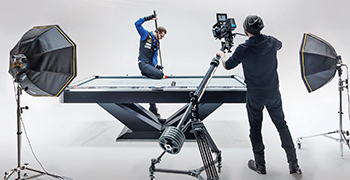 Kohler’s videos (this shot during filming of “Venom III”) are elaborate and intricate. “I remember he would finish, you know, toward the bottom of those first events,” Rossman said. “But he’d then slowly move up and eventually he would win the tournament.” He started knocking off bigger events, proving his merits alongside other competitors. But all the while, he knew his approach to trick shots never really aligned with tournaments. “I never really liked competition,” he said. “Trick shots is something that we have to have fun with. It is something to promote the game. I don’t think it’s really good as far as competition goes, because we’re losing the soul of the game.”
A Style His Own A quick way to ruin the fun of something is to sit down and ponder exactly why it’s enjoyable. Comedians, for example, are funny, except when they’re talking about what makes something funny. So much is true with Kohler, as well. He brings a unique approach to trick shots and his creativity is obvious. But it’s worth noting his unique entrance into pool.“He didn’t start as a pool player,” Rossman said. “I wanted to be a professional 9-ball player, but I never could quite get there, so I asked myself how I’m going to make a career in this game. But that’s the opposite of what Florian did. He started creating his own shots and doing his own thing.” Nine-ball is far from a stifling force for creativity; just watch Efren Reyes highlights. But Rossman’s point is curious, asking how Kohler’s development was affected by his desire to capture shots and distribute them in bite-sized videos on YouTube. “The videos were the perfect thing to keep me going because I had to invent new things,” he said. “Otherwise, I would’ve done a few and lost interest. But making videos, I had to push myself and force myself to come up with new shots and new presentations.” As far as those videos go, Kohler conservatively estimates his views, across platforms, tops one billion in total. Half of those are on pages he controls, including his YouTube channel with more than a million subscribers and 200 million views. He also added 150 million views with his two video collaborations with Dude Perfect, a channel formed by college friends who specialize in crazy trick shots and stunts in various sports.
What Lies Ahead Having moved to Las Vegas and now running American Poolplayers Association leagues in the area, Kohler has established himself as a leading personality for pool. No matter one’s feelings about trick shots or artistic pool, it’s hard to deny his exposure when his videos have been seen at least a billion times.But when it comes down to it, Kohler isn’t all that different from other trick shot artists. He considers himself an entertainer more than a social media figure. Having done 60 shows in 2019, Kohler knows these events are the core to his business. Social media, YouTube and Facebook provide income, but these avenues are more to market himself and his abilities. “To make serious money online, you need to have lots and lots of daily views plus a way to produce videos cheaply, which in my case really isn’t what I do,” he said. “We have a serious budget to make my bigger videos. So, definitely, the videos help me to stay relevant for the sponsors, market myself, and force me to push my limits and keep practicing.” But his online presence and his work with the APA, which has sponsored Kohler since 2014, may have to do a bit more of the heavy lifting in a post-COVID-19 world. The huge national amateur events in Las Vegas, at which Kohler often performs, are huge question marks at this point. The BCA Expo has been cancelled for 2020. These gatherings are essential for a performer like Kohler, though he knows other options are out there. 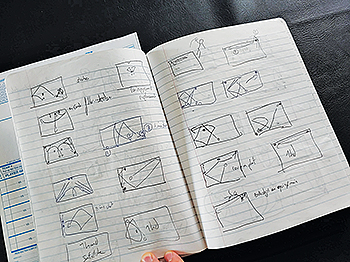 Kohler spends hours devising and experimenting with new shots. “The travel bans, they crippled economy and the lack of tournaments are really big concerns for me,” he said. “I’ll most likely need to try more and more to convert to a social media influencer rather than a trick shot artist.” The kid who honed his talent in his bedroom and flew to the U.S. with a few bucks and a lot of motivation has grown into one of sport’s leading entertainers. He built his brand by leveraging the tools of his generation, so if anyone can adapt and succeed in this new reality, it’d be tough to bet against Venom. Leave it to Rossman, one of the founding fathers of modern artistic pool, to put it in perspective: “Here’s this kid with this tremendous dream of doing crazy stuff on the table. And you know what? He’s made it work. Regardless of what anybody says, that’s awesome.” Tricks of the Trade It’s impossible to question Florian Kohler’s passion for trick shots and his artistic vision. In his dozen years tooling around the table, Venom has, by his calculations, invented north of 10,000 shots. His 410 videos and billion-plus views prove his approach is quality and quantity when it comes to his craft.Here are four of his go-to artistic shots–fully diagrammed with instructions for setup and execution. If you can’t pull these off just yet, don’t sweat it. Kohler got his start emulating the trick shot artists he found online at the time, so watch him pull these off and try to do ’em yourself. Shot 1: The Satellite Masse Setup: Take ball-in-hand anywhere in the red box. One object ball (the 8, as shown) should be placed along the center string of the table, a ball’s width from one diamond off the footrail. Two object balls (the 1 and 9) should be placed near the top left corner pocket.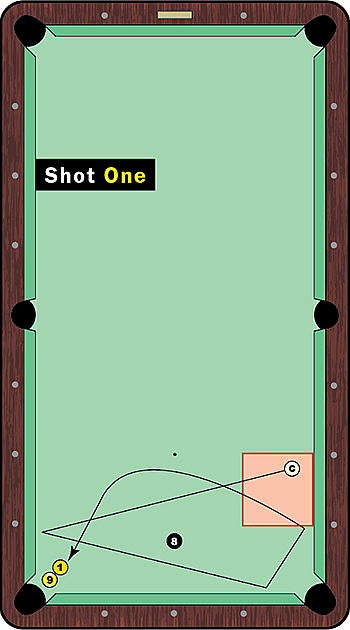 Execution: Masse the cue ball three rails around the obstacle ball, bending the cue ball after contact with the third rail to sink the combo sitting near the corner pocket. (Silicone or wax is mandatory for this shot.) Shot 2: The Double Masse Setup: Take ball-in-hand starting below the halfway mark of the rack, placed against the headrail. Place one object ball in the bottom left corner (the 8, as shown).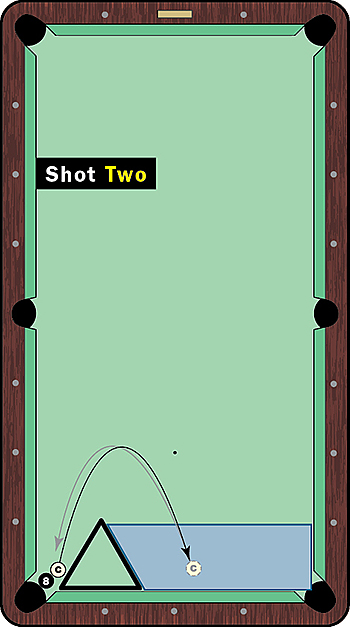 Execution: Masse the cue ball from left to right, around the triangle, as shown by the solid black arrow. Once the cue ball is in the blue region, masse it in the opposite direction, so it bends back around the triangle and pockets the object ball in the pocket. (Place a cue against the left long rail to help funnel the cue ball toward the object ball.) Silicone or wax can help, but make sure the cue ball doesn’t hit the footrail or stop between hits. Shot 3: The Criss Cross Twin Masse Setup: Two cue balls should be centered along the middle of the table, no more than a ball width from the short rail. The space between both cue balls should be less than a ball width. Place two object balls hanging near the corner pockets. Two triangles should be placed near the pockets, as diagrammed, frozen to the short rail. Two cues can be arranged to form a triangle, with the butts near the center string and pointing at their respective corner pocket. Execution: Using two masse cues simultaneously, shoot them so they cross paths on the way to sinking each object ball in the opposite corners. The cues can be touched by the cue balls and may work as guides to help pocket the object balls. (The two masse shots must be executed properly with one stroke, rather than hitting one cue ball after the other.) Shot 4: The Impossible Masse Setup: Place an object ball off the long rail near the corner pocket, with the cue ball no more than a ball width from it, as shown. Freeze a triangle against the long rail near the opposite corner pocket. A cue can be placed along the headrail to help guide the cue ball into the top right corner pocket.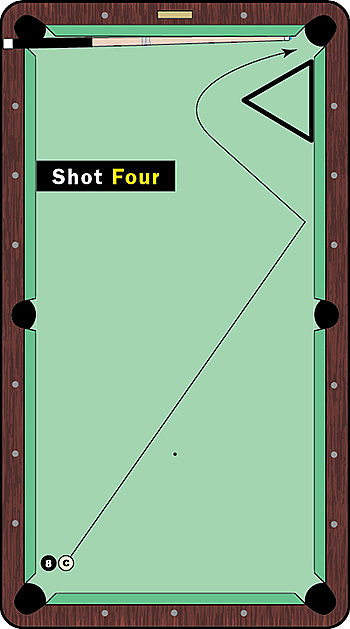 Execution: Masse the cue ball around the triangle after contacting the right long rail. The cue and triangle can help guide the cue ball into the pocket.
|
Since 1978, Billiards Digest magazine has been the pool world’s best source for news, tournament coverage, player profiles, bold editorials, and advice on how to play pool. Our instructors include superstars Nick Varner and Jeanette Lee. Every issue features the pool accessories and equipment you love — pool cues, pool tables, instruction aids and more. Columnists Mike Shamos and R.A. Dyer examine legends like Willie Mosconi and Minnesota Fats, and dig deep into the histories of pool games like 8-ball, 9-ball and straight pool.
Copyright © 1997 - 2025 Billiards Digest
All Rights Reserved
Luby Publishing, Inc.
310 Busse Highway PBM #319 | Park Ridge, IL 60068
Phone: 312-341-1110 | Fax: 312-341-1469